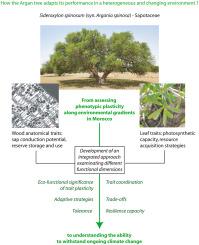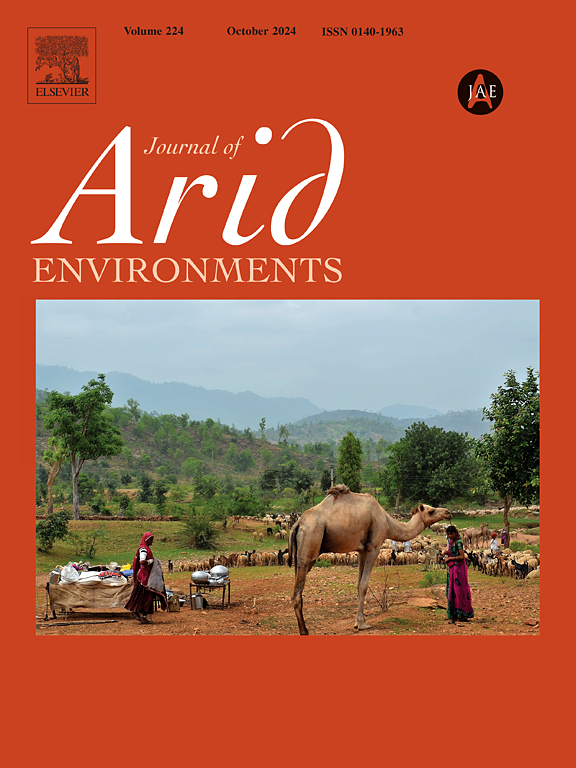了解摩洛哥坚果树如何利用木材解剖和叶片功能特征适应其在异质环境中的表现
IF 2.5
3区 环境科学与生态学
Q2 ECOLOGY
引用次数: 0
摘要
植物对环境因子的响应——具体来说,在本研究中,包括汁液传导潜能、资源利用和光合能力——通常涉及独立或相关性状的同时变化。为了更好地理解这些反应,我们开发了一种综合的方法来检查多个功能维度,定义为反映塑造阿甘树表型的约束和权衡的相关表型性状组。我们的目的是评估阿甘树承受持续气候变化的能力,特别是温度和干旱的显著增加。在本研究中,我们重点研究了与树液传导和储备储存相关的木材解剖性状,以及叶片的结构和生理性状。迄今为止,这些性状的组合还没有在阿甘树中得到系统的研究。通过整合这些功能维度,我们的方法使我们能够确定解释物种分布和对异质环境和气候压力的恢复能力的关键性状和性状组合。此外,它还可以识别对生物地理、地理和气候因素变化敏感的生物指标特征,促进基于特征的可塑性模型或沿环境梯度的适应性模型的发展。最终,本研究建立了摩洛哥坚果树的生态功能基础,为其对剧烈环境变化的耐受性和恢复力提供了见解。鉴于其生态、人类学和社会经济意义,了解这一标志性木本物种的适应策略对于预测其在日益增加的环境压力下的未来持久性至关重要。本文章由计算机程序翻译,如有差异,请以英文原文为准。

Understanding how the Argan tree adapts its performance in a heterogeneous environment using wood anatomical and leaf functional traits
Plant responses to environmental factors—specifically, in this study, sap conduction potential, resource use, and photosynthetic capacity—generally involve the simultaneous variation of both independent or correlated traits. To better understand these responses, we develop an integrated approach that examines multiple functional dimensions, defined as groups of correlated phenotypic traits that reflect the constraints and trade-offs shaping the Argan tree phenotype. Our aim is to assess the Argan tree's ability to withstand ongoing climate change, particularly the significant increase in temperature and aridity. In this study, we focus on wood anatomical traits related to sap conduction and reserve storage, alongside structural and physiological leaf traits. To date, this combination of traits has not been systematically studied in the Argan tree. By integrating these functional dimensions, our approach allows us to identify key traits and trait combinations that explain the species' distribution and resilience to heterogeneous environmental and climatic stressors. Furthermore, it enables the identification of bioindicator characters that are sensitive to variations in biogeographical, geographical and climatic factors, facilitating the development of trait-based models of plasticity or adaptation of performances along environmental gradients. Ultimately, this study establishes the eco-functional foundations of the Argan tree, providing insights into its tolerance and resilience to drastic environmental changes. Given its ecological, anthropological and socio-economic significance, understanding the adaptive strategies of this emblematic woody species is crucial for predicting its future persistence under increasing environmental pressures.
求助全文
通过发布文献求助,成功后即可免费获取论文全文。
去求助
来源期刊

Journal of Arid Environments
环境科学-环境科学
CiteScore
5.70
自引率
3.70%
发文量
144
审稿时长
55 days
期刊介绍:
The Journal of Arid Environments is an international journal publishing original scientific and technical research articles on physical, biological and cultural aspects of arid, semi-arid, and desert environments. As a forum of multi-disciplinary and interdisciplinary dialogue it addresses research on all aspects of arid environments and their past, present and future use.
 求助内容:
求助内容: 应助结果提醒方式:
应助结果提醒方式:


